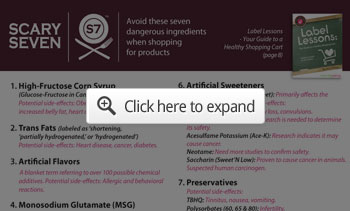The Eight Most Damaging Ingredients to Watch for on Food Labels
Processed foods are loaded with preservatives, artificial colors, and artificial flavorings, which is one of the reasons that I recommend avoiding them. Once you become a label reader, you’ll realize just how ubiquitous they are.
The best way to avoid toxic chemical additives is to consume only fresh whole foods. But practically speaking, this can be difficult for many people to accomplish, at least 100 percent of the time. Chances are that, despite your best efforts, you’ll have a processed food or two somewhere in your diet.
Therefore, it’s good to know which of the thousands of chemical additives are the most dangerous and should be avoided at all cost when you spot them on a food label.
An article recently posted on One Green Planet1 highlights eight particularly pernicious ingredients that you and your kids are probably eating. There seems to be good consensus about the worst of the worst, as seven of those were also dubbed the “Scary Seven”2 by Andrea Donsky of Naturally Savvy.
If you notice any of these on a food label, put it right back on the shelf! While I agree with all of One Green Planet’s choices, here I’ve selected my own “worst of the worst” ingredients found in processed foods.
1. Artificial Sweeteners
Studies have shown that tasting something sweet enhances your appetite, regardless of calories, and consuming artificial sweeteners has been shown to result in even greater weight gain than consuming sugar.
Aspartame appears to have the most pronounced effect, but the same applies for other artificial sweeteners, such as acesulfame potassium, sucralose, and saccharin. Unfortunately, weight gain is only the tip of the iceberg when it comes to the health hazards of artificial sweeteners.
Artificial sweeteners raise your risk of diabetes. A recent study in Nature3 told us why—they alter your gut microbiome for the worse. For example, best-selling artificial sweetener Splenda (sucralose) can destroy up to 50 percent of your beneficial gut flora.4
It’s been known for some time that consuming sucralose can cause or aggravate inflammatory bowel disease because of its interference with gastrointestinal function.5
 Both animal and human studies have shown that Splenda alters glucose and insulin function, thereby promoting weight gain, insulin resistance, and type 2 diabetes.
Both animal and human studies have shown that Splenda alters glucose and insulin function, thereby promoting weight gain, insulin resistance, and type 2 diabetes.
But there are additional concerns that sucralose may cause DNA damage, and when heated it releases chloropropanols, which are members of the extremely dangerous class of carcinogens called dioxins.6 Artificial sweeteners are a group of chemical additives that should be completely avoided.
2. Trans Fats and Vegetable Oils
Ever since the introduction of the first trans fat in 1911, Crisco, trans fats have been implicated in numerous serious health problems. First of all, they promote inflammation, which is a benchmark of most chronic disease.
Trans fats also interfere with basic cell membrane function, which can pave the way for cancer, diabetes, and cardiovascular disease.
Trans fats can radically raise your risk for stroke. A 2010 study involving post-menopausal women found a 30 percent higher incidence of ischemic strokes among those whose daily trans fat consumption was the highest.7
While trans fats are widely recognized as harmful and are largely being eliminated, many restaurants are reverting back to the use of synthetic vegetable oils, which may be creating even MORE of a problem due to the sheer volume people now consume.
Hydrogenated vegetable oils are in the vast majority of processed foods, including crackers, chips, fried foods, and many others. Americans eat more than 100,000 times more vegetable oils than at the beginning of the 20th Century—vegetable oils now comprise about seven or eight percent of all calories consumed.
Unlike trans fats, vegetable oils continue to be ignored despite the fact that they degrade into toxic oxidation byproducts when heated.
One byproduct category is cyclic aldehydes, which are highly inflammatory and may promote heart disease and Alzheimer’s. Vegetable oils such as soybean oil, canola, corn, and other oils have the additional risk of being genetic engineered and contaminated with glyphosate.
3. Artificial Flavors
 When you see the term “artificial flavors” on a label, there’s no way to know what it actually means. It could mean that one unnatural additive is included—or a blend of hundreds. For example, strawberry artificial flavor may contain around 50 chemical compounds.8
When you see the term “artificial flavors” on a label, there’s no way to know what it actually means. It could mean that one unnatural additive is included—or a blend of hundreds. For example, strawberry artificial flavor may contain around 50 chemical compounds.8
Some artificial flavorings have quite serious health concerns. For example, the butter flavoring added to microwave popcorn(diacetyl) has several implications for brain health and may contribute to beta amyloid plaques, which are associated with the development of Alzheimer’s disease.
4. Monosodium Glutamate (MSG)
MSG is an excitotoxin. This flavor enhancer is most often associated with Chinese food, but it’s actually added to countless processed food products ranging from frozen dinners and salad dressing to snack chips and meats. However, the term “monosodium glutamate” or its acronym MSG might not appear in the ingredient list. Instead, dozens of other names may be used, such as glutamic acid, hydrolyzed protein, yeast extract, and dozens of others. (You’ll find a full list here.)
Part of the problem is that free glutamic acid (MSG is approximately 78 percent free glutamic acid) is the same neurotransmitter that your brain, nervous system, eyes, pancreas, and other organs use to initiate certain processes in your body. Although the US Food and Drug Administration (FDA) continues to claim that consuming MSG does not cause ill effects, many experts report otherwise. MSG has been associated with obesity, eye damage, headaches, fatigue, disorientation, depression, rapid heartbeat, and numbness and tingling.
5. Artificial Colors (Dyes)
Every year, food manufacturers pour 15 million pounds of artificial food dyes into US foods.9 However, a 2014 study10 by Purdue University suggests that children may be consuming far more toxic food dyes than previously thought. A variety of common food dyes and the preservative sodium benzoate cause some children to become more hyperactive and distractible. The amounts of dye in even single servings of some foods are higher than the amounts proven to adversely affect children’s behavior. Many of these dyes are derived for coal tars.11
 Nine of the food dyes currently approved for use in the US are linked to health issues ranging from cancer to hyperactivity and allergy-like reactions—and these results were from studies conducted by the chemical industry itself.12 For instance, Red #40, which is the most widely used dye, may accelerate the appearance of immune system tumors in mice, while also triggering hyperactivity in children. Blue #2, used in candies, beverages, pet foods, and more, was linked to brain tumors. And Yellow #5, used in baked goods, candies, cereal, and more, may not only be contaminated with several cancer-causing chemicals but is also linked to hyperactivity, hypersensitivity, and other behavioral effects in children.
Nine of the food dyes currently approved for use in the US are linked to health issues ranging from cancer to hyperactivity and allergy-like reactions—and these results were from studies conducted by the chemical industry itself.12 For instance, Red #40, which is the most widely used dye, may accelerate the appearance of immune system tumors in mice, while also triggering hyperactivity in children. Blue #2, used in candies, beverages, pet foods, and more, was linked to brain tumors. And Yellow #5, used in baked goods, candies, cereal, and more, may not only be contaminated with several cancer-causing chemicals but is also linked to hyperactivity, hypersensitivity, and other behavioral effects in children.
6. High-Fructose Corn Syrup (HFCS)
It’s often claimed that HFCS is no worse for you than sugar, but when you look at contemporary scientific research, you’ll see this is not the case. Americans are consuming massive quantities of fructose, especially in the form of high-fructose corn syrup, because it’s cheap and easily added to processed foods. HFCS contains free-form monosaccharides of fructose and glucose, so it cannot be considered biologically equivalent to sucrose (table sugar), which has a glycosidic bond that links the fructose and glucose together and slows its break down in your body.
And fructose is hidden throughout the American diet, in food items that may surprise you, including baby foods and condiments. Fructose is primarily metabolized by your liver, because that is the only organ that has the transporter for it. In your liver, fructose is metabolized much like alcohol, causing mitochondrial and metabolic dysfunction in the same way as ethanol and other toxins. And just like alcohol, your body turnsfructose directly intofat.
As a standard recommendation, I advise keeping your TOTAL fructose consumption below 25 grams per day. For most people, it would be wise to limit your fructose from fruit to 15 grams. I would also encourage you to have your blood uric acid level checked. High uric acid is a potent marker for fructose toxicity, so if your levels are above the following, then you’d be wise to avoid all forms of fructose until your levels have normalized—just as you would with elevated insulin.
- 4 mg/dl for men
- 3.5 mg/dl for women
7. Preservatives
Preservatives lengthen the shelf life of foods, increasing manufacturers’ profits—at your expense, since most are linked to health problems such as cancer, allergic reactions, and more. Since this is a broad category with far too many chemical compounds to list here, I’ll highlight my top five.
| Preservative | Where It’s Found | Potential Health Risks |
|---|---|---|
| BHA and BHT (butylated hydroxyanisole and butylated hydrozyttoluene) | Chewing gum, breakfast cereals, breads, crackers, potato chips, nut mixes, and many others | Neurological problems, behavioral issues, hormonal issues, metabolic dysfunction, and cancer |
| TBHQ (tertiary-butyl hydroquinone) | Instant noodles, crackers, candy, commercial pizza, and many others | Nausea and vomiting, tinnitus, delirium, sense of suffocation, liver toxicity, and reproductive mutations; so deadly that just 5 grams can kill you |
| Sodium benzoate | Soft drinks, fruit juices, salad dressings, pickles, and others | Hyperactivity, asthma, cirrhosis of the liver, Parkinson’s disease, and cancer |
| Sodium nitrite and nitrate | Deli meats, bacon, ham, smoked fish, and hot dogs | Colorectal, stomach, and pancreatic cancers |
| Azodicarbonamide | Dough conditioner in commercial baked goods (a plastic chemical found in yoga mats and shoe rubber)13 | Cancer, asthma, and allergies |
8. Genetically Engineered Ingredients
New research on genetically engineered (GE) foods, continues to confirm the danger of adding GE ingredients to processed foods. Unfortunately, GE ingredients are NOT listed on the label! We’re getting closer to passing of labeling laws, but we’re not there yet. If at all possible, I recommend avoiding all foods containing genetically modified organisms (GMOs) by selecting only those that are certified organic. The latest GMO study, involving pigs, was one of the most robust scientific studies ever done about the health effects of a GE diet.
 Most pigs raised in the US are typically fed a mixture of GE soy and corn. Researchers discovered that this diet causes severe inflammation in the pigs’ stomachs. Overall, inflammation levels were 2.6 times higher in GE-fed pigs than those fed a non-GE diet. While sows were 2.2 times more likely to have severe stomach inflammation when eating GE feed, male pigs were four times more likely to suffer severe stomach inflammation. The GE diet tested simulated that consumed by a typical American, who will be exposed to a variety of different GE foods through his or her daily diet, rather than just one at a time. According to the Non-GMO Project:14
Most pigs raised in the US are typically fed a mixture of GE soy and corn. Researchers discovered that this diet causes severe inflammation in the pigs’ stomachs. Overall, inflammation levels were 2.6 times higher in GE-fed pigs than those fed a non-GE diet. While sows were 2.2 times more likely to have severe stomach inflammation when eating GE feed, male pigs were four times more likely to suffer severe stomach inflammation. The GE diet tested simulated that consumed by a typical American, who will be exposed to a variety of different GE foods through his or her daily diet, rather than just one at a time. According to the Non-GMO Project:14
“Most developed nations do not consider GMOs to be safe. In more than 60 countries around the world, including Australia, Japan, and all of the countries in the European Union, there are significant restrictions or outright bans on the production and sale of GMOs. In the US, the government has approved GMOs based on studies conducted by the same corporations that created them and profit from their sale. Increasingly, Americans are taking matters into their own hands and choosing to opt out of the GMO experiment.”
US Sends ‘Healthier Processed Foods’ to Other Countries
Many foods sold in the US are banned in other countries due to their harmful additives, growth promoters, genetically engineered ingredients, or other dangerous practices. Artificial food dyes, bromate-containing drinks and bread, and carcinogenic preservatives are just a few examples. The food industry has already formulated safer, better products for other countries where harmful ingredients are banned—so why do they insist on selling inferior versions in America? The fact that Americans are in poorer health and die younger than people in other developed countries makes you wonder whether toxic foods might be playing a role.
There are countless examples of US federal regulatory agencies having sold out to industry at the expense of your health, while other countries have chosen to protect their citizens by embracing the precautionary principle. If you want to avoid questionable foods and potentially harmful ingredients, then ditching processed foods is your best option. About 90 percent of the money Americans spend on food is for processed foods, so there is significant room for improvement in this area for most people.
Learning to read labels (and understand what may NOT be on the label) is an important part of this process, as most people find they are unable to avoid processed foods 100 percent of the time. If you need some guidance about how to make your diet healthier, I invite you to check out my optimized nutrition plan.
~~ Help Waking Times to raise the vibration by sharing this article with friends and family…


